AP Physics 1 Semester 1 Final
1/57
There's no tags or description
Looks like no tags are added yet.
Name | Mastery | Learn | Test | Matching | Spaced |
|---|
No study sessions yet.
58 Terms
A ball is thrown straight “up” in the air. When the ball reaches its highest point, which of the following is true?
E. None of the “above”
An object is thrown with an initial speed v near the surface of Earth. Assume that air resistance is negligible and the gravitational field is constant.
If the object is thrown vertically “upward”, the direction and magnitude of its acceleration while it is in the air is
E. “downward” and constant
A lion is running at constant speed toward a gazelle that is standing still, as shown in the top figure above. After several seconds, the gazelle notices the lion and accelerates directly toward him, hoping to pass the lion and force him to reverse direction. As the gazelle accelerates toward and past the lion, the lion changes direction and accelerates in pursuit of the gazelle. The lion and the gazelle eventually each reach constant but different speeds. Which of the following sets of graphs shows a reasonable representation of the velocities of the lion and the gazelle as functions of time?
A.
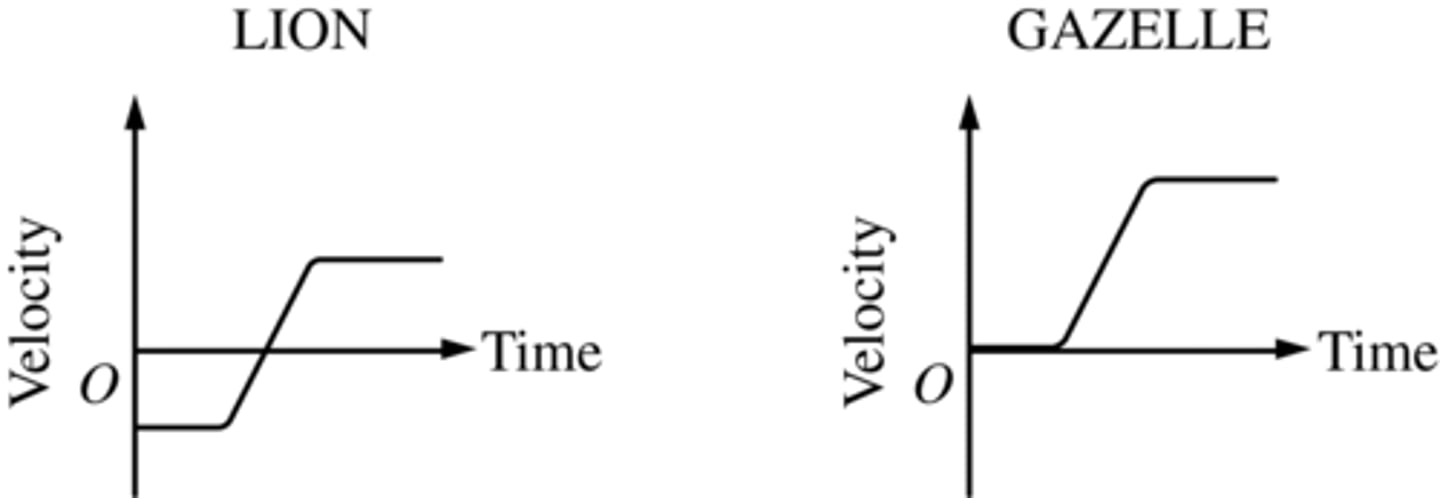
The position and velocity of a car moving along a straight road are recorded as functions of time, as shown in the graphs above. Which of the following correctly describes the car's speed and acceleration?
C.

In a lab, a block weighing “8”0 N is attached to a spring scale, and both are pulled to the right on a horizontal surface, as shown above. Friction between the block and the surface is negligible. What is the acceleration of the block when the scale reads 32 N?
C. “4”.0 m/s^2
“Identical blocks” A and B are initially at rest on ramps inclined at different angles and with their centers of mass at the same height, as shown above. The ramps are frictionless except for rough sections 1 and 2 represented by the jagged lines, which have the same coefficient of kinetic friction. The blocks are released. How do the speeds of the blocks compare when they are at the locations represented by the dashed rectangles at the bottom of each ramp?
B. Block B has a “greater” speed.
An object travels down a ramp at a constant acceleration. The object experiences a force of friction and a “gravitational force”. Which of the following could be true about the motion of the object?
A. The force of friction between the surface and the object is “less” than the component of the gravitational force that is parallel to the ramp.
The left figure shows a block at rest on a rough inclined surface. The block is attached to a wall by a string of negligible mass. The vector sum of the forces is zero. The right figure shows the free-body diagram for the block. The string is cut and the vector sum of the forces on the block remains zero. Which of the following free-body diagrams could show the forces exerted on the block after the string is cut?
B.
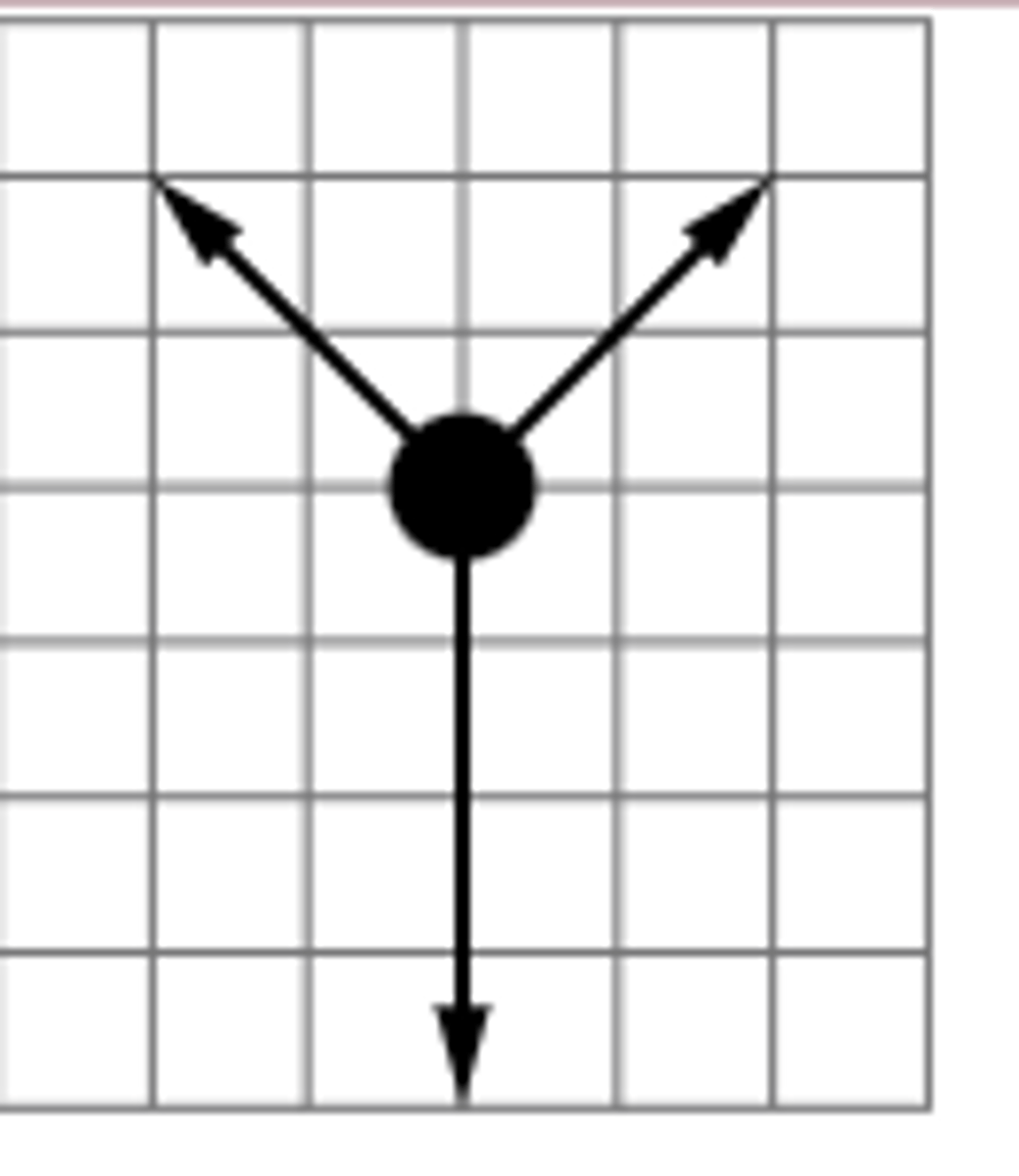
A “puck” slides freely across the horizontal surface of a frozen pond with negligible friction. Which of the following is true of the motion of the puck?
D. The puck will slide with a “constant velocity”.
A person of mass 90kg stands on a scale in an “elevator”. The scale reads 1100N. Which of the following is a correct claim about the direction of the elevator's motion?
D. The elevator could possibly be moving “downward and slowing down.”
The figure above shows a truck pulling three crates across a rough road. Which of the following shows the directions of all the horizontal forces acting on crate 2 ?
C.

The figure above shows the forces exerted on a block that is sliding on a rough horizontal surface: The weight of the block is 500 N, the normal force is 500 N, the frictional force is 100 N, and there is an unknown force F exerted to the right. The acceleration of the block is “0.4 m/s2.” The value of F is most nearly
D. “120” N
Three identical blocks, X, Y, and Z, hang from identical strings, as shown in the figure. Which of the following free-body diagrams could represent the forces exerted on block Y?
B.
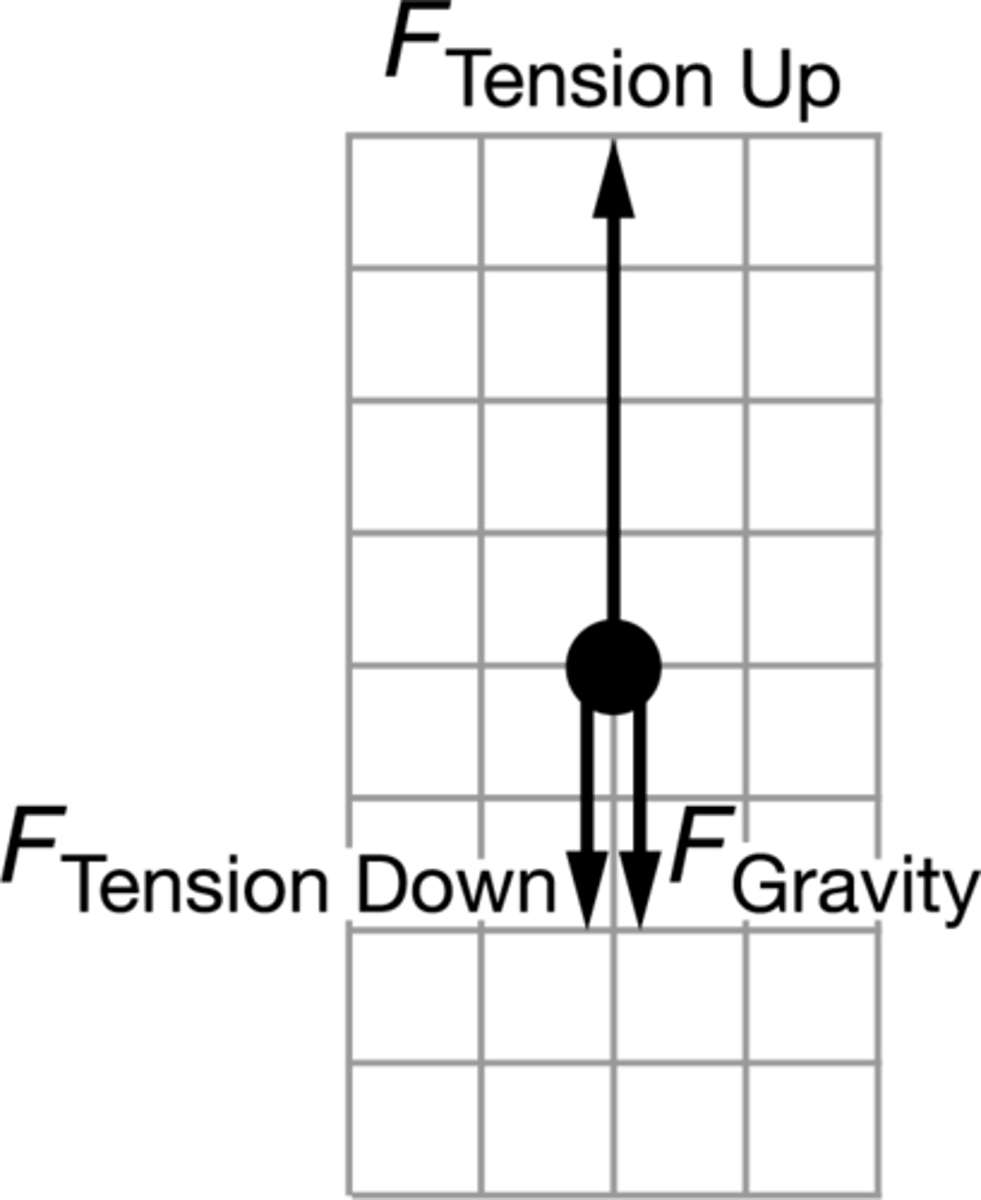
The diagram above represents the forces exerted on a box that a “child” is holding. FN represents the force applied by the child's hand, and Fg represents the weight of the box. The child begins to raise the box with increasing speed. Which of the following claims is correct about force Fh that is exerted by the box on the child's hand as the box is being raised?
B. Fh”=”FN, where FN is larger as the box is being raised than when it was being held.
“Two identical books” are stacked on a table. A third identical book is then placed on top of the first two, causing an increase in the normal force exerted by the bottom book on the middle book. Which of the following is a correct explanation for the increase in this normal force?
D. The third book produces an additional downward force on the middle book, “thus increasing” the upward force exerted by the bottom book to maintain equilibrium.
“A motor swings” a ball on a string in a vertical circle such that the tension in the string is constant throughout the ball's motion. Which of the following correctly indicates at which point the ball has the greatest speed and provides a valid justification?
A. “At the topmost point”, because the tension force and gravitational force are both directed toward the center of the ball's motion.
A cart of mass m rolls past the circular bottom of a “hill” (point P). Which of the following statements about the normal force Fn exerted on the cart at point P is correct?
D. Fn is “greater” than mg at point P, because the cart is experiencing an upward acceleration.
The figure above shows the forces exerted on a block that is sliding on a horizontal surface: the gravitational force of 40 N, the 40 N normal force exerted by the surface, and a frictional force exerted to the left. The coefficient of friction between the block and the surface is “0.20”. The acceleration of the block is most nearly
D. “2.0” m/s2 to the left
An object slides across a horizontal surface such that it slows down due to the force of friction that is exerted on the object. The object and the direction of its displacement are shown in the figure. Which of the following free-body diagrams could represent the forces that are exerted on the object?
A.
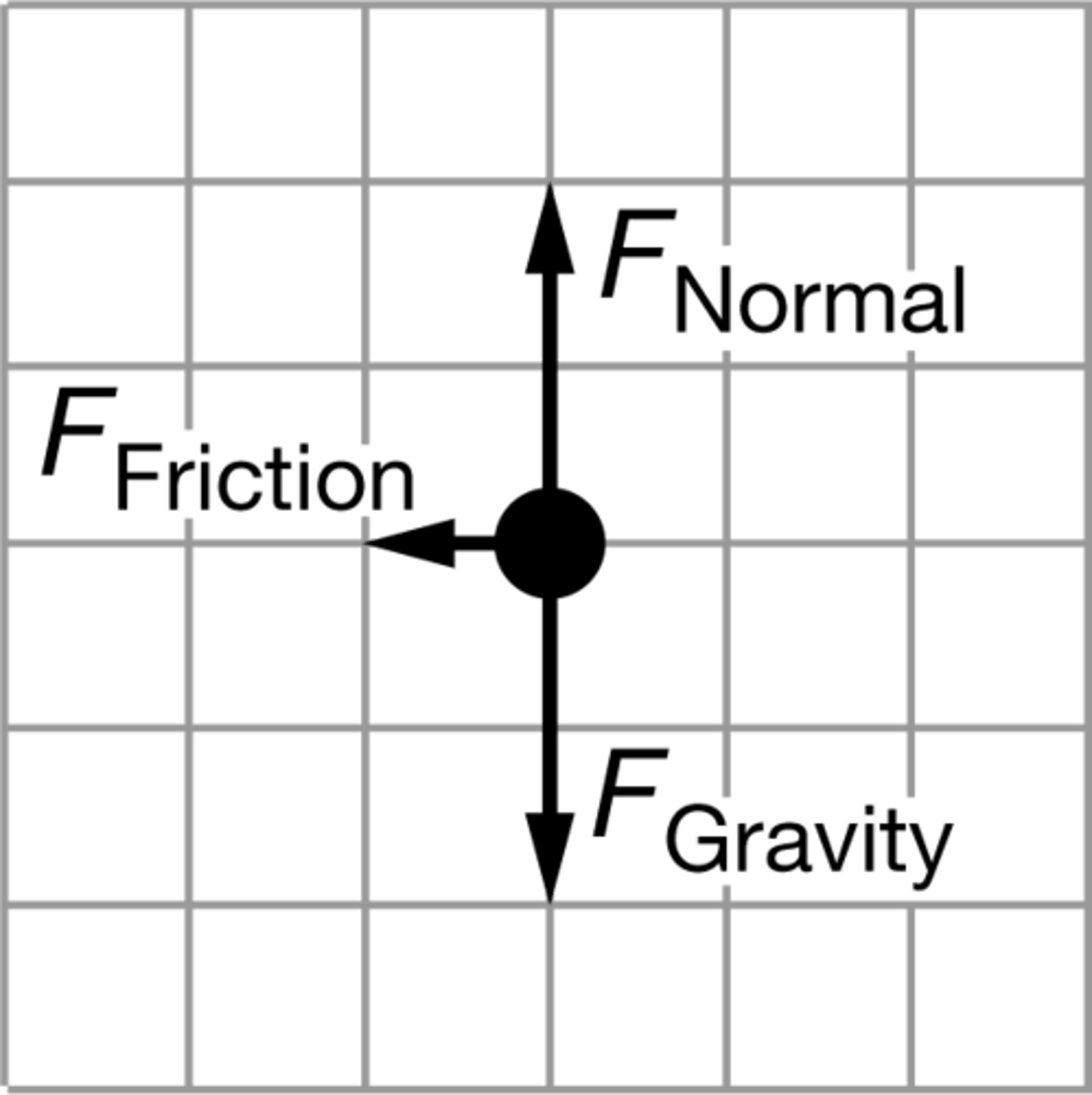
The stacks of boxes shown in the figure above are inside an elevator that is moving upward. The masses of the boxes are given in terms of the mass M of the lightest box.
Assume the elevator is moving at constant speed, and consider the bottom box in the stack that has two boxes of mass 2M. Let Ffloor be the force exerted by the floor on the box, Fg be the force exerted by gravity on the box, and Fbox be the force exerted by the top box on the bottom box. Which of the following best represents the forces exerted on the bottom box?
C.
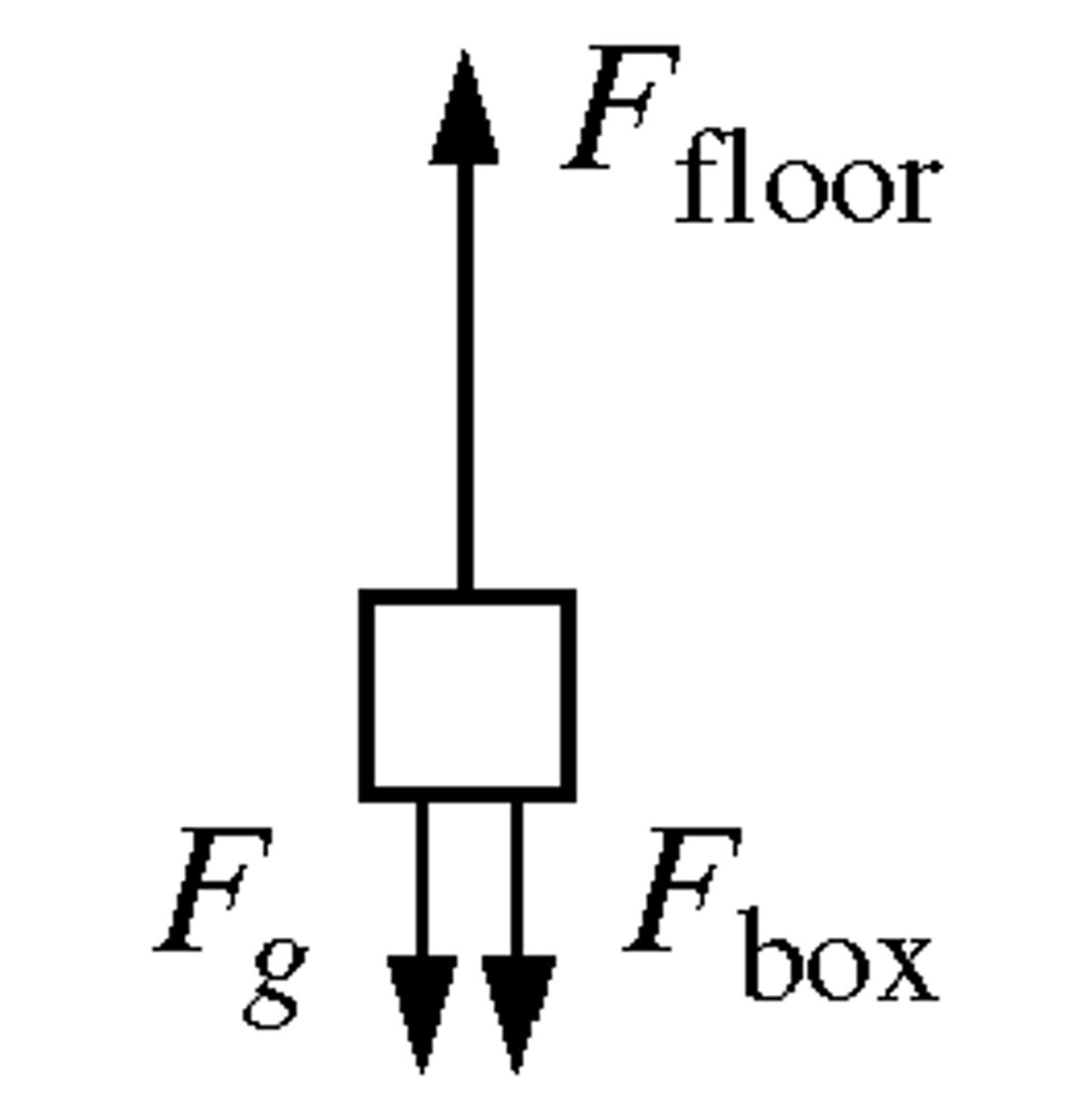
Object “X” and object “Y” are at rest on a horizontal surface. Object X is in contact with object Y. The force diagrams for both objects are shown above. Which two forces make up an action-reaction pair?
D. “F3 and F6”, because both forces are exerted on different objects, have the same magnitude, and are in opposite directions.
Blocks A and B, of masses m and 2m, respectively, are connected by a “light string” and pulled across a surface of negligible friction with a constant force F1, as shown above. The acceleration of the blocks is a. The force of the string pulling block B forward has magnitude F2. Which of the following claims correctly describes the relationship between the magnitude of the forces acting on the blocks?
B. F1 is “greater” than F2.
Three blocks are pushed along a rough surface by a force with magnitude P, as shown above. FC is the magnitude of the contact force between blocks 2 and 3, and Ff, FN, and FG are the magnitudes of the friction, normal, and gravitational forces on block 3, respectively. Which of the following is a correct free-body diagram for block 3?
C.
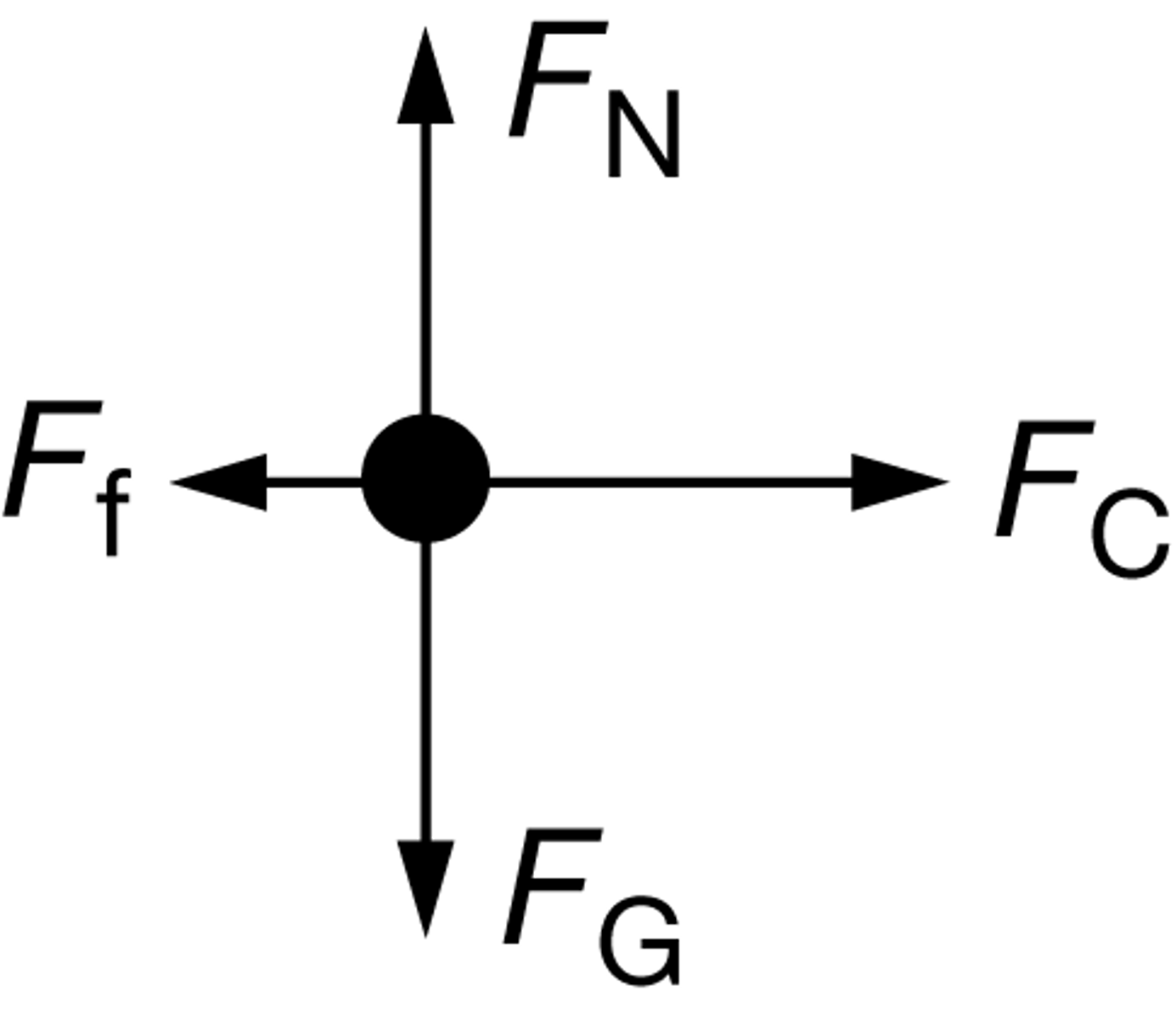
A sled slides along a vertical circular track of radius r, as shown. There is negligible friction between the sled and the track. At the bottommost point of the track, the sled has speed vb. Which of the following graphs best show the normal force exerted by the track on the sled at the bottommost point of the track as a function of vb?
D.
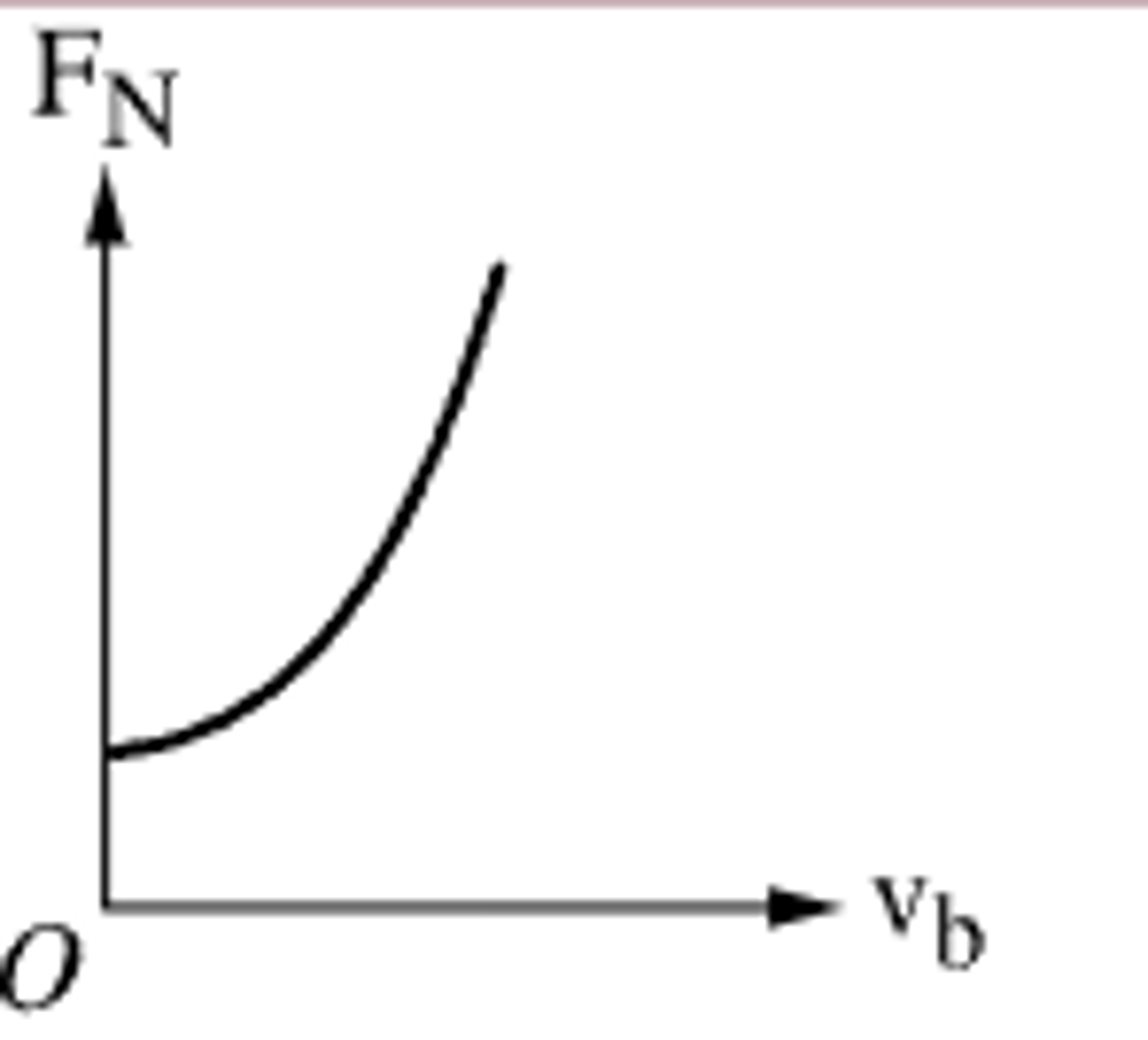
One end of a string is held in place and the other end of the string is attached to a disk. The disk can be set in motion and travel in a circular path with constant speed along a horizontal surface. A force sensor with negligible mass is attached to the string, as shown in the figure. There is negligible friction between both the disk and force sensor and the surface. A student sketches the graph shown of the force measured by the force sensor for several values of the speed. Is the “student's sketch” accurate? Why or why not?
B. “Yes”, because centripetal force “increases” proportional to the square of the speed.
A planet has “two moons”, Moon A and Moon B, that orbit at different distances from the planet's center, as shown. Astronomers collect data regarding the planet, the two moons, and their obits. The astronomers are able to estimate the planet's radius and mass.
What additional information is needed to determine the time required for one of the moons to make one complete revolution around the planet?
C. The “distance” between the center of each moon and the planet.
An “astronaut” in the space station appears weightless because the astronaut seems to float. Which of the following claims is true about the force exerted on the astronaut by Earth?
C. The force exerted on the astronaut by Earth is “equal” to the force exerted on Earth by the astronaut.
A student plans to conduct an “experiment” in which the momentum of a two-object system can be determined immediately before and after a collision takes place. The student slides block X at an unknown constant speed toward an identical block, block Y, that is initially at rest, as shown in the figure. There is negligible friction between the blocks and the surface.
table
The student uses the data collected from the experiment to create the data table. Which of the following statements is true regarding the data?
C. The momentum of the two-block system is “not conserved” because the initial momentum of the system is “not equal” to the final momentum of the system.
A force of constant magnitude “F” and fixed direction acts on an object of mass m that is initially at rest. If the force acts for a time interval “∆t” over a displacement ∆x , what is the magnitude of the resultant change in the linear momentum of the object?
A. “F ∆t”
Three objects can only move along a straight, level path. The graphs below show the position d of each of the objects plotted as a function of time t.
image of “3” d vs t graphs
The magnitude of the momentum of the object is increasing in which of the cases?
B. “III” only.
image
A force probe is used to push a box across a smooth surface, as shown in the figure. Frictional forces are considered to be negligible. The force probe collects data about the force exerted on the box as a function of time. The data are used to create the graph that is shown. During which “time interval” does the box experience the greatest change in its momentum?
C. “4 s to 6 s”.
A ball is dropped and “bounces” off the floor. Its speed is the same immediately before and immediately after the collision.
Which of the following is true about the collision between the ball and the floor?
B. The ball's momentum “changes” direction but “not magnitude”.
image
On a straight horizontal track along which blocks can slide with negligible friction, block 1 slides toward block 2, which is initially at rest. Block 1 collides with an electronic force probe attached to block 2, generating a force vs. time graph and causing block 2 to start “sliding”. What additional measurements must be made to determine the momentum of block 2 after the collision?
A. “None”.
images
Two carts of masses 1kg and 2kg travel together, as shown in Figure 1. At time t=2 s, a “compressed spring” inside the 2kg cart expands, and the carts separate. Figure 2 shows a graph of the carts' velocities as a function of time. What is the magnitude of the change in linear momentum, if any, of the two-cart system between t=0 s and t=4 s?
A. “0” kg x m/s
A 4 kg object moving to the left collides with and “sticks” to a 3 kg object moving to the right. Which of the following is true of the motion of the combined objects immediately after the collision?
D. The motion “cannot be determined” without knowing the speeds of the objects before the collision.
graph
A “2kg” object travels across a horizontal surface with a constant speed of 6ms. An applied force that increases with time is then exerted on the object. A graph of the force exerted on the object as a function of time is shown. The applied force is in the direction of the object's displacement. All frictional forces are considered to be negligible. What is the object's speed after the force has been applied for 4s?
B. “22” m/s
image
A spaceship of mass 3m is in deep space, far from any other objects, traveling with speed 3v to the left, as shown in the top figure. The spaceship separates into two pieces, with masses 2m and m, as shown in the bottom figure. The piece with mass 2m moves to the left with speed 4v. “Why” does the piece of mass m move to the “left” with speed v?
C. There is no external force on the system so the momentum of the system “must remain constant.”
graph
During an experiment a student records the “net horizontal” force exerted on an object moving in a straight line along a horizontal frictionless track. The graph above shows the force as a function of time. Of the following, which is the best approximation of the magnitude of the change in momentum of the object between 0 s and 4 s?
B. “30” kg x m/s
A “12” kg box sliding on a horizontal floor has an initial speed of “4.0” m/s. The coefficient of friction between the box and the floor is 0.20. The box moves a distance of 4.0 m in 2.0 s. The magnitude of the change in momentum of the box during this time is most nearly
B. “48” kg x m/s
scatterplot
A student conducts an experiment in which an object travels across a horizontal surface while for 2 s a net force is applied to a 2 kg object that initially travels with a speed of 0.5 m/s. Data collected from the experiment are used to create the graph of the magnitude of the applied force exerted on the object as a function of time is shown. All frictional forces are considered to be negligible. “Can the student use the graph” and the known data to determine the momentum of the object after the force has been applied?
D. “No”, because the student needs to know the direction that the force is applied to the object because the applied force will be in the same direction as the “change” in momentum of the object.
f vs t graph
A 0.050 kg “tennis” ball is moving to the left at 10 m/s when it is hit by a tennis racket that is moving to the right. The magnitude of the force exerted on the ball by the racket as a function of time is shown in the figure above. What is the speed of the ball after the collision with the racket?
A. “30” m/s
A block of mass m slides along a horizontal surface and collides with a force sensor that reports the average force F exerted by the block on the sensor and the total time Δt of the collision. Friction between the block and the surface is negligible. Which of the following expressions is equal to the “magnitude of the change” in the velocity of the block during the collision?
B. “FΔt” / m
two towers next to each other
A brick is dropped from the top of a building and falls toward the ground. In “Case A”, the brick lands on concrete and breaks into many pieces. In Case B, the brick lands on a thin foam pad and does not break. Why does the brick not break in Case B but breaks in Case A?
D. Because the foam pad “increases the time” that the force is applied to the brick to stop it.
A constant force of magnitude F delivers an impulse J to an object over time t. A second constant force delivers an impulse 2J to the same object over a time t / 2. What is the magnitude of the “second force”?
D. “4”F
graph
The graph shows force as a function of time for two carts of different masses. The carts are on straight, horizontal tracks and the forces are exerted “parallel” to the track. Cart A has mass m0 and Cart B has mass 2m0. Is the impulse delivered to Cart B greater than that of Cart A for the time period from t=0 to t=tf? Why or why not?
D. No, because the areas under the “curve” for both cars are “equal”.
An object attached to one “end of a string” moves in a circle at constant speed. Which of the following is correct?
A. The object is “accelerating” as it moves.
A student wants to launch a “toy dart” toward a target that hangs from a light string. At time t=0, the dart is launched with an initial speed v0 at an angle θ0 above the horizontal ground. At the instant the dart is launched, the string is cut such that the target begins to fall straight down. The positive horizontal direction is considered to be to the right, and the positive vertical direction is considered to be up.
A student makes the necessary measurements to create the graph shown, which represents the vertical component of the velocity as a function of time for the dart and for the target from t=0 until the instant the dart hits the target. At t=0, the target is a vertical distance h above the dart. The curves for the dart and the target each have the same area between them and the horizontal axis. Both curves also have the same slope.
cont. Which of the following is the best method to determine the distance h from the graph?
B. Find “twice the area” under the curve for the dart's data.
A student wants to launch a toy dart toward a target that hangs from a light string. At time t=0, the dart is launched with an initial speed v0 at an angle θ0 above the horizontal ground. At the instant the dart is launched, the string is cut such that the target begins to fall straight down. The positive horizontal direction is considered to be to the right, and the positive vertical direction is considered to be up.
model
Which of the following graphs could represent the vertical component of the velocity as a function of time for the dart and the target immediately after the dart is launched and the target begins to fall?
D.
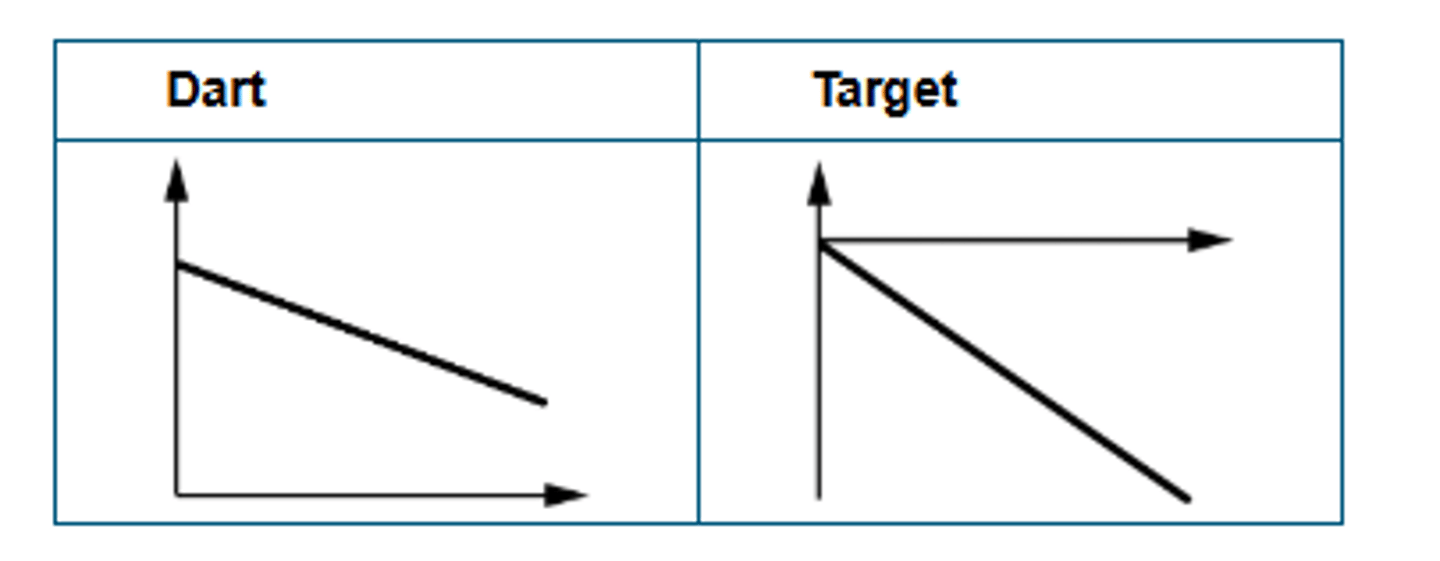
Two students want to determine “the speed at which a ball” is released when thrown vertically upward into the air. One student throws the ball into the air while the other student measures the total time that the ball is in the air. The students use a meterstick to measure the release height of the ball. Which of the following equations should the students use to determine the speed at which the ball was released?
B. Use y=y0 + vy0t + “1/2”ayt^2 from the moment in time in which the ball was released to the moment in time in which the ball hits the ground.
Balls 1 and 2 are each thrown horizontally from the same height above level ground, but ball 2 has a greater initial velocity after leaving the thrower's hand. If air resistance is negligible, how do the accelerations of the balls and the times it takes them to hit the ground compare?
E.

At time t=0, a projectile is launched from the top of a cliff at an angle of 30 degrees below the horizontal. Which of the following pairs of graphs best represents the horizontal displacement Δx and the vertical velocity component v vert of the projectile as a function of time t?
A.
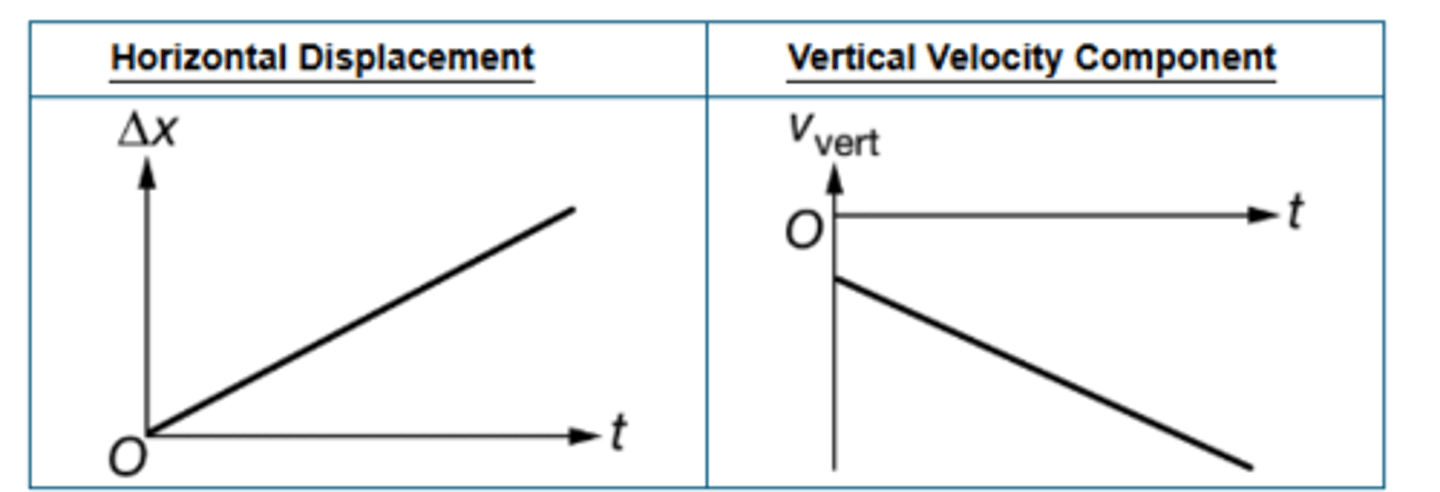
graph
The motion of an object is shown in the “velocity-time” graph. Which best describes the motion of the object?
C. The object travels in the “same direction” for the entire time.
dot graph
A student performs an experiment in which the horizontal position of a toy car is recorded on “ticker tape” from a device that places dots on the tape in equal time intervals. The series of dots in the figure represents the motion of an object moving from the negative direction to the positive direction along the horizontal direction. The time interval between each recorded dot is 1s. Which of the following experiments could the student have conducted to create the data shown on the ticker tape?
B. A toy car that initially “increases” its speed, travels at a constant speed, and then “decreases” its speed.
2 f vs t graphs
Objects X and Y are constrained to move along a straight line. The graphs above show the net force exerted along that line on each of the objects as functions of time. Which of the following “correctly ranks” the change in momentum Δp of the objects?
B. Δpx”=”Δpy
f vs t graph
An object of mass m is moving in the positive x-direction with an initial speed v. Starting at time t=0, a time-varying force F with initial magnitude F0 is exerted on the object in the positive x-direction. Measurements of the force as a function of time are represented in the graph above. Which of the following statements is true about the motion of the object between t=0 and “t=t1” ?
B. The momentum of the object has increased by approximately “1/2” F0t1.
An object of mass 5kg travels in the positive direction with a speed of 1ms. The object collides with a second object that exerts an average net force over an interval of time such that the 5kg object “comes to rest”. Which of the following best predicts the change in momentum for the 5kg object?
A. The change in momentum is in the “negative” direction.
How does an “air mattress” protect a stunt person landing on the ground after a stunt?
E. It “lengthens the stopping time” of the stunt person and “reduces the force” applied during the landing.
A student throws a small lump of “clay” directly upward. The student then swings a heavy rod at the clay and, at the instant the clay comes to rest at its maximum height, the rod collides with the clay. The clay immediately sticks to the rod. Which of the following correctly indicates which object, if either, experiences an impulse of greater magnitude because of the collision, and provides a valid justification?
D. “Neither”, because the change in momentum of the clay is “equal” and opposite to that of the rod.